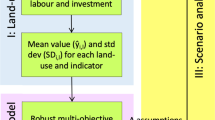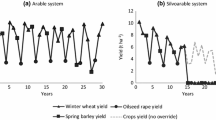Abstract
Design of agroforestry systems requires a land management planning process that clearly specifies wants, needs and objectives along with the land's suitability for potential agroforestry practices. Within this planning process economic analysis can be used to analyze agroforestry alternatives to help determine the proper system to apply. Specifically, production economics coupled with capital theory and valuation techniques can provide measures of economic performance in terms of present net values, benefit-cost ratios and internal rates of return. These economic performance measures can be used to determine the best joint production level for a particular agroforestry practice. Once these best combinations have been defined, linear programming can be applied using these ‘best’ joint production combinations as decision variables along with considering a wide range of additional constraints and requirements. A hypothetical example is used to illustrate the planning process and how these economic tools can be combined as a package to help determine optimal agroforestry strategies.
Similar content being viewed by others
References
Arnold JEM (1982) Economic considerations in agroforestry projects. Agroforestry Systems 1: 299–311
Betters DR (1978) Analytical aids in land management planning. In: Operational Forest Management Planning Methods. USDA Forest Service Technical Report PSW-32, Pacific Southwest Forest and Range Experiment Station, Berkeley, CA pp 91–99
Better DR and Rubingh JR (1978) Suitability analyses and wildland classification. Journal of Environmental Management 7: 59–72
Blandon P (1985) Agroforestry and portfolio theory. Agroforestry Systems 3: 239–249
Dykstra DP (1984) Mathematical programming for natural resources. McGraw-Hill. 318 pp
Etherington DM and Matthews DJ (1983) Approaches to the economic evaluation of agroforestry systems. Agroforestry Systems 1: 347–360
Harou PA (1983) Economic principles to appraise agroforestry projects. Agricultural Administration 12: 127–139
Hoekstra DA (1985) Choosing the discount rate for analyzing agroforestry systems/technologies from a private economic viewpoint. Forest and Environmental Management 10: 177–183
Hoekstra DA (1985) Economic concepts of agroforestry, Int'l Council for Research in Agroforestry, PO Box 30677, Nairobi, Kenya. 12 pp
Raintree JB (1982) Bioeconomic considerations in the design of agroforestry intercropping systems. Int'l Council for Research Agroforestry, PO BOx 30677, Nairobi, Kenya. 24 pp.
Verinumber I, Knipscheer HC and Enabor GE (1984) The economic potential of leguminous tree crops in zero-tillage cropping in Nigeria: a linear programming model. Agroforestry Systems 2: 129–138
Author information
Authors and Affiliations
Rights and permissions
About this article
Cite this article
Betters, D.R. Planning optimal economic strategies for agroforestry systems. Agroforest Syst 7, 17–31 (1988). https://doi.org/10.1007/BF01890467
Issue Date:
DOI: https://doi.org/10.1007/BF01890467




